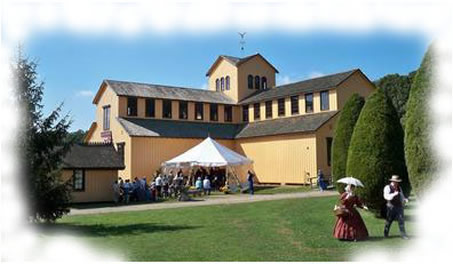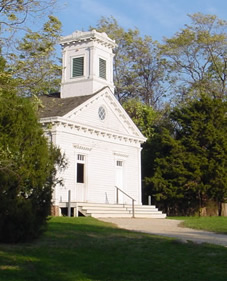Old Bethpage Village Restoration
Old Bethpage, 1303 Round Swamp Road
(Exit 48 of the Long Island Expressway)
516-572-8400
The Village is Open for the 2014 Season
Normal Hours:
Wednesday through Sunday 10am - 4pm (last ticket sold at 3 p.m.)
Museum Admission: $10, adults; $7, children 5 - 12 (under 5 are free); and $7, seniors, volunteer firefighters.
For School & Group Reservations, please call 516 572-8408 for pricing & reservations.
For Restoration Farm reservations visit: www.restorationfarm.com
Click here for Google map

The reconstructed Exhibition Hall today. After 170 years the Long Island Fair continues as the only county fair sanctioned by New York State for the counties of Queens, Nassau and Suffolk .
Exploring Long Island's 19th-Century Living History Museum
OLD BETHPAGE VILLAGE RESTORATION provides visitors with a unique and wonderful opportunity to step back in time and experience life in a recreated mid-19th-century American village. The 209-acre village includes an assortment of homes, farms and businesses.
Each fall, the village hosts the Long Island Fair, a traditional county agricultural fair that draws tens of thousands of visitors. Most of the year the village supports a steady series of family-friendly events and exhibits. One of the events included are the old-time "baseball" tournaments.
Old Bethpage Village Restoration (OBVR) came into existence in 1963, when Nassau County acquired the Powell property, a 165-acre farm located on the Nassau-Suffolk border. The acquisition of the land and the plan to develop a historic restoration were timely, as rapid post-World War II development on Long Island had taken a toll on the area's landmarks.
Although OBVR never existed as an historic entity, it represents a typical rural Long Island farm village of the mid-19th century — one whose roots can actually be found in the earlier Dutch and English settlement of Long Island.
During the 1640s, the colonial settlers founded town "spots" throughout the region that functioned as commerical and social centers where taverns, general stores and meeting houses were built. Townsmen received a centrally located town lot as well as outlying fields to use for grazing livestock, growing crops or havesting firewood.
By 1700, the English had gained control of Long Island, townships controlled whatever land had not already been distributed and the economy had expanded to include trades dependent on the sea and land. Life remained quiet, unhurried and closely tied to nature — patterns that were evident until well into the 19th century and that can be experienced at OBVR.
 |
The Manetto Hill Church (above),
dating to
1857, and the Long Island
Fair
Exhibit Hall (above) are two of
the dozens of buildings at OBVR. |
IN 1963, PLAINVIEW'S HISTORIC MANETTO HILL METHODIST CHURCH was the first structure to be saved and moved to the Powell property. Today, there are 51 historic buildings, seven reconstructions and the site encompasses 209 acres. Buildings were selected based on their architectural detail and historic significance, with the goal of establishing a representative sampling of historic structures.
After buildings were moved to the village, they were carefully restored to a specific point in their history and the lives of the former occupants thoroughly researched.
Each structure has been scrutinized for clues to its role in community life, authentic hardware, shingles and glass sought — with the help of wills, deeds and inventory lists — so the structures could be authentically furnished (in some cases with pieces original to the building).
Among the historic buildings is the Schenck House, built around 1730 and one of the oldest Dutch farmhouses remaining in the U.S. The house displays typical massive Dutch framing, particularly on the first floor ceiling joists, which span 32 feet.
Other notable features include a side gabled roof with flared eaves, round butt shingles, heavy window sash and a massive stone jambless fireplace.
Another is the Benjamin House, built in 1829 by William F. Benjamin, a Congregational minister, farmer and pastor to the Shinnecock and Poosepatuck Native American tribes. (One of Benjaman's brothers, Simeon, wasa prominent merchant and a founder of Elmira College, the first institution of higher learning for women.) The Benjamin House was constructed in the late Federal country style and its furnishings reflect the lifestyle of this relatively affluent farmer and respected minister.
Visit Old Bethpage Village to see these buildings and others and allow yourself to be transported into an earlier time in the history of Long Island and New York.
 |
Sustainable Farming
at Old Bethpage Village
IN 2007, THE COUNTY INTRODUCED the Restoration Farm at Old Bethpage Village. The farm, which is operated by a private business, Restoration Farmers, employs sustainable, organic agricultural principles and follows the "Farmer's Pledge" of the Northeast Organic Farming Association of New York. The farm itself is 7 acres and is located at the southern tip of the Village. The farm's produce is available to the public through a farm stand at the entrance to the Restoration Farm at 14 Bethpage-Sweet Hollow Road (Spagnoli Road) (Wednesdays
from
4
-
6
p.m.;
Sundays
from
10 am
-
noon, June 2 through
October 30) and via the Community Supported Agriculture program.
For more information about Restoration Farm,
click here. |
|

Step Back In Time This Summer With the Junior Apprentice Education Program
Children from 9 to 12 can leave the 21st century behind and step into 1850s Long Island by wearing clothing and participating in activities from the time period. This unique children’s summer program is being offered at Old Bethpage Village Restoration.
There are three 1 week sessions, $250.00 per week. Limited spots available. Call for Application 516 572-8401
|

MANGANO OFFICIALLY OPENS MUSEUM OF AMERICAN ARMOR
Old Bethpage, NY - On the 70th Anniversary of D-Day, Nassau County Executive Edward P. Mangano officially opened the new Museum of American Armor on the grounds of Old Bethpage Village Restoration with more than 20 operational armor vehicles and D-Day veterans. County Executive Mangano was joined by Congressman Peter King, Museum founder Lawrence Kadish, former New York Police Commissioner Ray Kelly and The History Channel’s Chief Historian and Vice President Dr. Libby O’Connell.
The Museum of American Armor is made possible by a public-private partnership that generates new revenue for the recreation village and creates a permanent living classroom for a new generation of Americans to appreciate the battlefield sacrifices made on their behalf.
Nassau County Executive Mangano stated, “The ability to create an armored column that replicates the sights and sounds of American forces during World War II is one of the most compelling educational tools we have to recount the story of our GIs' courage, valor and sacrifice. Place it in this setting of vintage farmhouses and country roads so reminiscent of the WWII era Normandy countryside, and you have created a virtual time machine that ensures indelible memories for families.”
Operational vehicles on public display include the iconic Sherman tank, a Stuart tank used extensively by the Marines during their Pacific campaigns, a potent 155 mm howitzer, reconnaissance vehicles that acted as armored scouts for American forces, anti-aircraft guns and similar weapons that broke the back of the Axis powers during World War II. Other vehicles range from a classic LaSalle staff car in the markings of a Fleet Admiral, to jeeps, weapons carriers and half-tracks.
Mr. Kadish stated, “WW II will continue to fascinate current and future generations because the stark depiction of good versus evil is so dramatic. In addition, everyone has someone in their family’s history who fought in that war, survived the carnage or was lost during that conflict. It also reminds us that the current War on Terror still demands American courage in the face of relentless evil.”
Beyond World War II programs, the Museum includes tributes to the American service men and women who have served in Korea, Vietnam, the Gulf, Iraq, Afghanistan and the War on Terror so that the museum is able to fulfill its mission of honoring America’s defense of freedom throughout the decades.
In recognition of the economic power of heritage tourism, the Cuomo Administration, New York State Senator Dean Skelos and Assemblyman Charles Lavine have directed some $1.6 million towards the Museum’s construction.
In a joint statement, Senator Skelos and Assemblyman Lavine explained, “In addition to the power of this museum to pay tribute to the American soldier, it is also an economic generator that strengthens our tourism destination industry, a growing factor in our local economy. The rate of return for the taxpayer will be significant as the armor museum attracts national and international visitors to its operational collection.”
The museum is open Wednesday through Saturday, 10:00 a.m. to 4:00 p.m. and on Sunday 10:00 a.m. to 5:00 p.m. Admission is $10 for adults; $7 for children ages 5 - 12 (under 5 are free); and $7 for seniors, volunteer firefighters and veterans. Admission to the Museum of American Armor also provides visitors with access to Old Bethpage Village Restoration.
|